Related Research Articles
In communications and information processing, code is a system of rules to convert information—such as a letter, word, sound, image, or gesture—into another form, sometimes shortened or secret, for communication through a communication channel or storage in a storage medium. An early example is an invention of language, which enabled a person, through speech, to communicate what they thought, saw, heard, or felt to others. But speech limits the range of communication to the distance a voice can carry and limits the audience to those present when the speech is uttered. The invention of writing, which converted spoken language into visual symbols, extended the range of communication across space and time.

Electrical telegraphy is a point-to-point text messaging system, primarily used from the 1840s until the late 20th century. It was the first electrical telecommunications system and the most widely used of a number of early messaging systems called telegraphs, that were devised to send text messages more quickly than physically carrying them. Electrical telegraphy can be considered the first example of electrical engineering.

Morse code is a telecommunications method which encodes text characters as standardized sequences of two different signal durations, called dots and dashes, or dits and dahs. Morse code is named after Samuel Morse, one of the early developers of the system adopted for electrical telegraphy.

Telegraphy is the long-distance transmission of messages where the sender uses symbolic codes, known to the recipient, rather than a physical exchange of an object bearing the message. Thus flag semaphore is a method of telegraphy, whereas pigeon post is not. Ancient signalling systems, although sometimes quite extensive and sophisticated as in China, were generally not capable of transmitting arbitrary text messages. Possible messages were fixed and predetermined, so such systems are thus not true telegraphs.

The Q-code is a standardised collection of three-letter codes that each start with the letter "Q". It is an operating signal initially developed for commercial radiotelegraph communication and later adopted by other radio services, especially amateur radio. To distinguish the use of a Q-code transmitted as a question from the same Q-code transmitted as a statement, operators either prefixed it with the military network question marker "INT" or suffixed it with the standard Morse question mark UD.

American Morse Code — also known as Railroad Morse—is the latter-day name for the original version of the Morse Code developed in the mid-1840s, by Samuel Morse and Alfred Vail for their electric telegraph. The "American" qualifier was added because, after most of the rest of the world adopted "International Morse Code," the companies that continued to use the original Morse Code were mainly located in the United States. American Morse is now nearly extinct—it is most frequently seen in American railroad museums and American Civil War reenactments—and "Morse Code" today virtually always means the International Morse which supplanted American Morse.
Ham radio is a popular term for amateur radio, derived from "ham" as an informal name for an amateur radio operator. The use first appeared in the United States during the opening decade of the 20th century—for example, in 1909, Robert A. Morton reported overhearing an amateur radio transmission which included the comment: "Say, do you know the fellow who is putting up a new station out your way? I think he is a ham." However, the term did not gain widespread usage in the United States until around 1920, after which it slowly spread to other English-speaking countries.

The Phillips Code is a brevity code (shorthand) compiled and expanded in 1879 by Walter P. Phillips for the rapid transmission of telegraph messages, including press reports.

Procedural signs or prosigns are shorthand signals used in Morse code telegraphy, for the purpose of simplifying and standardizing procedural protocols for landline and radio communication. The procedural signs are distinct from conventional Morse code abbreviations, which consist mainly of brevity codes that convey messages to other parties with greater speed and accuracy. However, some codes are used both as prosigns and as single letters or punctuation marks, and for those, the distinction between a prosign and abbreviation is ambiguous, even in context.

Morse code abbreviations are used to speed up Morse communications by foreshortening textual words and phrases. Morse abbreviations are short forms, representing normal textual words and phrases formed from some (fewer) characters taken from the word or phrase being abbreviated. Many are typical English abbreviations, or short acronyms for often-used phrases.
The history of amateur radio, dates from the dawn of radio communications, with published instructions for building simple wireless sets appearing at the beginning of the twentieth century. Throughout its history, amateur radio enthusiasts have made significant contributions to science, engineering, industry, and social services. Research by amateur radio operators has founded new industries, built economies, empowered nations, and saved lives in times of emergency.
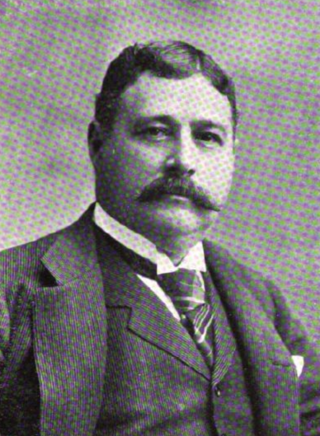
Walter Polk Phillips was an American journalist, telegrapher, and inventor who compiled and expanded telegraph codes with his Phillips Code, a brevity code which included the abbreviations POTUS, for president of the United States, and SCOTUS, for Supreme Court of the United States. He later became the head of the United Press.

-30- has been traditionally used by journalists in North America to indicate the end of a story or article that is submitted for editing and typesetting. It is commonly employed when writing on deadline and sending bits of the story at a time, via telegraphy, teletype, electronic transmission, or paper copy, as a necessary way to indicate the end of the article. It is also found at the end of press releases.
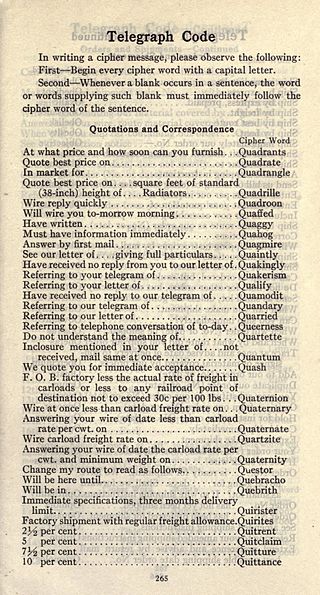
In telecommunication, a commercial code is a code once used to save on cablegram costs. Telegraph charged per word sent, so companies which sent large volumes of telegrams developed codes to save money on tolls. Elaborate commercial codes which encoded complete phrases into single words were developed and published as codebooks of thousands of phrases and sentences with corresponding codewords. Commercial codes were not generally intended to keep telegrams private, as codes were widely published; they were usually cost-saving measures only.
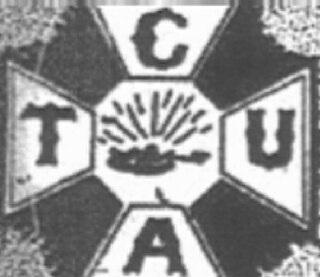
The Commercial Telegraphers Union of America (CTUA) was a United States labor union formed to promote the interests of commercial telegraph operators.

Although they often faced obstacles and policy limitations, beginning in the early 1900s a few women were able to participate in the pioneering development of radio communication.
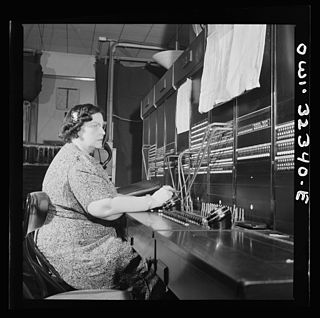
Women in telegraphy have been evident since the 1840s. The introduction of practical systems of telegraphy in the 1840s led to the creation of a new occupational category, the telegrapher, telegraphist or telegraph operator. Duties of the telegrapher included sending and receiving telegraphic messages, known as telegrams, using a variety of signaling systems, and routing of trains for the railroads. While telegraphy is often viewed as a males-only occupation, women were also employed as telegraph operators from its earliest days. Telegraphy was one of the first communications technology occupations open to women.
Brevity codes are used in amateur radio, maritime, aviation and military communications. They are designed to convey complex information with a few words or codes. Some are classified from the public.

Valparaiso Technical Institute (1874–1991), previously located in Valparaiso, Indiana, was originally established by G.A. Dodge as a department of Northern Indiana Normal School. After its reorganization in 1891 the school became the largest telegraph and railway instruction institution in the United States, and was known as "The Dodge Institute of Telegraphy."
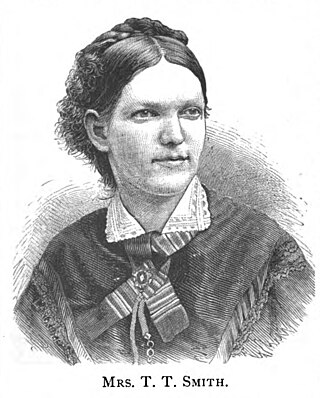
Emma A. Hunter (1831–1904) was an American telegraph operator from West Chester, Pennsylvania. She was hired by the Atlantic and Ohio Telegraph Company in 1851 and worked as a telegrapher until 1868. She is known as the second female telegrapher in Pennsylvania, preceded only by Helen Plummer of Greenville in 1850. Although she was widely noted in her lifetime as the first female telegrapher in the United States, historical research has shown she was not. However, she may have been the first telecommuter, as Thomas Jepsen has argued.
References
- 1 2 "1859 Western Union "92 Code" & Wood's 1864 "Telegraphic Numerals" & Comparison of Alphabetic Telegraph Codes" . Retrieved 2008-11-23.
- ↑ Dodge, G.M. (1901). The telegraph instructor. Valparaiso, Ind.: Not Given. p. 50.
- ↑ "Women in amateur radio - Amateur-radio-wiki". www.amateur-radio-wiki.net. Retrieved 2016-08-01.
- ↑ "Telegraph Rules: Adopted October 1, 1873 By Lake shore and Tuscarawas valley railway company". 1873.